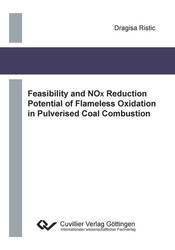| Departments | |
|---|---|
| Book Series (96) |
1378
|
| Nachhaltigkeit |
3
|
| Gesundheitswesen |
1
|
| Humanities |
2362
|
| Natural Sciences |
5406
|
| Engineering |
1790
|
| Engineering | 291 |
| Mechanical and process engineering | 861 |
| Electrical engineering | 686 |
| Mining and metallurgy | 30 |
| Architecture and civil engineering | 75 |
| Common |
97
|
|
Leitlinien Unfallchirurgie
5. Auflage bestellen |
|
Advanced Search
Feasibility and NOx Reduction Potential of Flameless Oxidation in Pulverised Coal Combustion (English shop)
Dragisa Ristic (Author)Preview
Extract, PDF (140 KB)
Table of Contents, PDF (51 KB)
Since the 1990, the flameless oxidation technology has been successfully proven as low-NOx combustion technology for gaseous hydrocarbon fuels, and the recent application of this technology to solid fuels such as pulverised coal has also become an area of interest.
The objective of this thesis is to evaluate the feasibility and the potential of the flameless oxidation technology in the pulverised coal combustion. Firstly, the experimental studies on pulverised coal flameless oxidation process are conducted at a bench-scale test facility (5 to 10 kWth). In the next step, a suitable burner design in a pilot scale of approximately 300 kWth is developed, built up and experimentally studied. Detailed exhaust gas and inflame measurements of the temperature and, main species are carried out in order to address the specific aspects of pulverised coal flameless oxidation. Furthermore, to indicate the relevant NOx reduction mechanisms in the pulverised coal flameless oxidation process.
In contrast to the conventional pulverised coal combustion, which has luminous and aerodynamically stabilised flames, the flameless oxidation combustion process has been achieved without a clearly visible flame. In the pulverised coal flameless oxidation mode, intensive internal recirculation is enhanced by a high injection velocity of the combustion air, and thus dilutes the combustion zone and heats up the coal particles in the primary pyrolysis zone. Once the coal particles are rapidly heated up, the processes of pyrolysis and volatile matter release are facilitated. Consequently, local reducing zone is formed, devolatilisation is enhanced, ignition delay is suppressed, combustion stability is improved and NOx emissions are reduced remarkably.
A high internal recirculation of the oxygen-lean hot combustion products into the primary pyrolysis zone promotes an early devolatilisation and a decrease in ignition delay, which are two important factors for NOx reduction processes. Hence, a valuable potential of pulverised coal flameless oxidation is in the improved homogeneous gas phase kinetics and an enhanced homogeneous NO reburning mechanism. Besides NO reduction in the homogeneous gas phase, it is indicated that the NO reduction on the char surface in the heterogeneous and homogeneous gas phases is important as well, i.e. char NO reduction reaction and catalytic reduction of NO by CO on the char surface, in the pulverised coal flameless oxidation.
As an overall conclusion, the PC FLOXTM (Pulverised Coal Flameless Oxidation) burner technology generally is evaluated as a perspective technology to provide low cost low NOx burners for utility boilers. Moreover, the PC FLOXTM burner technology offers the possibility of a lower cost alternative to the current approach of utilising SCR to enable power plants to meet current and future specific requirements on NOx emissions. However, despite all the advantages of this technology, it has been recognised that there are considerable technical challenges to the implementation of PC FLOXTM burners in utility boilers. High pressure loss in the main combustion air supply, boiler and burner design, arrangement of burners, start-up and shutdown procedures, etc. all require significant further work in order to bring the PC FLOXTM burner technology closer to the utility scale boilers.
| ISBN-13 (Hard Copy) | 9783954042609 |
| ISBN-13 (eBook) | 9783736942608 |
| Final Book Format | A5 |
| Language | English |
| Page Number | 144 |
| Lamination of Cover | glossy |
| Edition | 1. Aufl. |
| Publication Place | Göttingen |
| Place of Dissertation | Stuttgart |
| Publication Date | 2012-10-30 |
| General Categorization | Dissertation |
| Departments |
Engineering
Mechanical and process engineering |
| Keywords | Technische Mechanik, Strömungsmechanik, Thermodynamik, Umwelttechnik, Allgemeine Verfahrenstechnik, Kohleverbrennung, Kraftwerkstechnik, flameless oxidation, coal combustion, NOx formation, NOx reduction |








